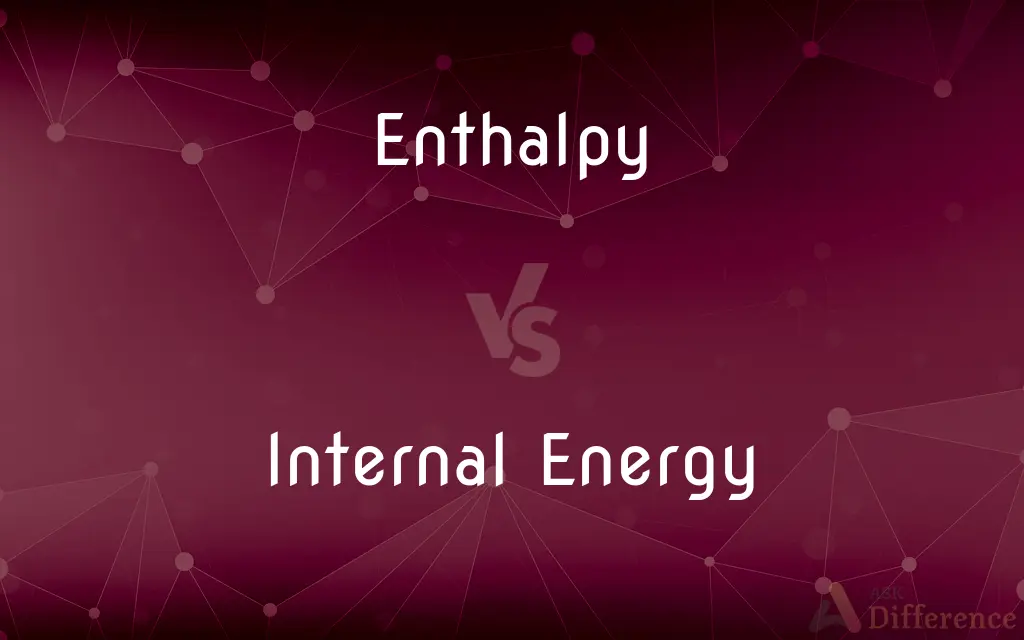Enthalpy vs. Internal Energy — What's the Difference?
By Tayyaba Rehman — Published on October 15, 2023
Enthalpy (H) represents the total heat content in a system and is calculated by adding the internal energy (U) to the work done by pressure. Internal energy (U) encompasses all energy stored within a system, including kinetic and potential energies.

Difference Between Enthalpy and Internal Energy
Table of Contents
ADVERTISEMENT
Key Differences
Enthalpy is essentially the total heat content of a system and is particularly pertinent in processes at constant pressure. In contrast, Internal Energy pertains to the entirety of the energy contained within a system, considering both kinetic and potential energies.
Enthalpy is often utilized in the context of thermodynamic processes where the pressure is held constant, like chemical reactions in a beaker. Whereas, Internal Energy is a more generalized term, encapsulating all energy forms present in a system.
In the realm of chemistry and physics, Enthalpy is primarily invoked in the analysis of heat transfer during chemical reactions, especially under constant pressure. Internal Energy, however, is relevant in numerous contexts due to its comprehensive encompassment of all energy forms.
When observing a system undergoing a chemical reaction, Enthalpy changes signify the heat absorbed or released, assuming constant pressure. Conversely, variations in Internal Energy represent the difference between energies put into and taken from a system.
Enthalpy is contextually significant for studying heat exchanges in isobaric processes, providing insights into heat flow. In the broad spectrum, Internal Energy offers a macroscopic perspective, considering all internal kinetic and potential energy interactions.
ADVERTISEMENT
Comparison Chart
Definition
Total heat content of a system.
Total energy stored within a system.
Mathematical Expression
H = U + PV
U is not explicitly defined.
Units
Joules (J) in the International System.
Joules (J) in the International System.
Significance
Crucial in constant pressure processes.
Applicable in varied contexts.
Change Indication
Represents heat transfer in reactions (constant P).
Reflects energy transfer into/out of a system.
Compare with Definitions
Enthalpy
Enthalpy is defined as the heat content within a system.
When ice melts, the Enthalpy change is positive, indicating heat absorption.
Internal Energy
Internal Energy encompasses all energy forms within a system.
A heated gas has increased Internal Energy due to escalated molecular activity.
Enthalpy
Enthalpy is pertinent in assessing heat changes at constant pressure.
Combustion reactions release heat, showing a negative change in Enthalpy.
Internal Energy
Internal Energy is influenced by heat transfer and work done on/by the system.
Compressing a gas increases its Internal Energy by performing work on it.
Enthalpy
Enthalpy is often utilized in understanding thermochemical equations.
Examining Enthalpy changes helps scientists evaluate reaction feasibilities.
Internal Energy
Internal Energy can change through various forms of energy transfer.
Heating a solid elevates its Internal Energy via kinetic energy enhancement.
Enthalpy
Enthalpy change represents the heat transfer during a reaction at constant pressure.
Exothermic reactions have negative Enthalpy changes due to heat release.
Internal Energy
Internal Energy can be altered via physical processes or chemical reactions.
In an isolated system, Internal Energy remains constant (First Law of Thermodynamics).
Enthalpy
Enthalpy reflects the total energy of a system plus the product of pressure and volume.
In isobaric conditions, the change in Enthalpy directly relates to heat flow.
Internal Energy
Internal Energy includes kinetic and potential energies at the microscopic level.
Chilled liquids have lower Internal Energy due to diminished molecular motion.
Enthalpy
Symbol H A thermodynamic function of a system, equivalent to the sum of the internal energy of the system plus the product of its volume multiplied by the pressure exerted on it by its surroundings.
Enthalpy
A measure of the heat content of a chemical or physical system.
, where H is enthalpy, U is internal energy, p is pressure, and V is volume.
Enthalpy
(thermodynamics) a thermodynamic quantity equal to the internal energy of a system plus the product of its volume and pressure;
Enthalpy is the amount of energy in a system capable of doing mechanical work
Common Curiosities
How can Internal Energy be altered?
Through heat transfer, work, and particle interactions within the system.
What constitutes Internal Energy?
It encompasses all kinetic and potential energies within a system.
In what context is Enthalpy often used?
Frequently used to describe heat changes in processes at constant pressure.
Can Enthalpy be negative?
Yes, negative Enthalpy signifies heat being released in a process.
How is Internal Energy related to heat and work?
It can be increased by adding heat or performing work on the system.
What is "enthalpy of formation"?
It's the Enthalpy change when one mole of a substance forms from its elements.
What is the First Law of Thermodynamics regarding Internal Energy?
Energy can neither be created nor destroyed, only converted between forms.
Is Internal Energy dependent on path functions?
No, it's a state function and depends only on the current state of the system.
How is Enthalpy defined?
It's the total heat content within a system, calculated as U + PV.
What is the relation between Enthalpy, pressure, and volume?
Enthalpy (H) equals Internal Energy (U) plus the product of pressure (P) and volume (V).
Is Enthalpy a state function?
Yes, Enthalpy depends only on the initial and final states, not the path taken.
How are Enthalpy and Internal Energy related to thermodynamics?
They’re crucial concepts for understanding energy transfer in thermodynamic systems.
What influences Internal Energy in gas systems?
Temperature, pressure, volume, and particle interactions alter it.
How does an exothermic reaction affect Enthalpy?
It decreases Enthalpy, as heat is released to the surroundings.
Does Internal Energy have a standard measurement condition?
No standardized condition, it's typically derived from related properties.
Share Your Discovery

Previous Comparison
Amendment vs. Clause
Next Comparison
Online UPS vs. Offline UPSAuthor Spotlight
Written by
Tayyaba RehmanTayyaba Rehman is a distinguished writer, currently serving as a primary contributor to askdifference.com. As a researcher in semantics and etymology, Tayyaba's passion for the complexity of languages and their distinctions has found a perfect home on the platform. Tayyaba delves into the intricacies of language, distinguishing between commonly confused words and phrases, thereby providing clarity for readers worldwide.














































